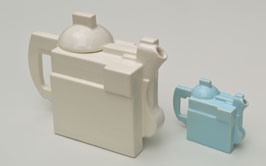This year it is exactly 90 years ago that Kazimir Malevich introduced his famous teapot in 1923 at the State Porcelain Factory in Saint-Petersburg in Russia. To celebrate this event Geometric Abstraction has just launched a new reproduction model — called the Malevich Teapot 2.0 — and it is manufactured using 3D printing with ceramic materials by Shapeways.
The backstory to the original teapot is an interesting one, as history quite often is, and dates back to the foundation, in 1744, of the Imperial Porcelain Factory in Saint Petersburg, to produce high quality porcelain exclusively for the Tsar and the Imperial Court. Soon after the Bolshevik October Revolution of 1917, however, the factory was nationalized and renamed the State Porcelain Factory. The old traditional bourgeois order was swept away and a revolutionary director was installed who invited artists with radical, modernist ideas to design avant-garde ceramics and porcelain that was “revolutionary in content, perfect in form and flawless in technical execution.” I don’t know about you, but when I think Russian Revolution, teapot is not the first thing that comes to mind. And yet, what this story shows is how deep the concept of revolution penetrated the Russian consciousness at the time and was to be reflected at even the most basic level — even when drinking tea!
During a very short but intense period, between the end of 1922 and April 1924, the ‘Suprematists’ were allowed fearless experimentation with utopian, fresh, radical abstract designs based on the square, circle and cross. The Suprematism founder and prophet Kazimir Malevich (1878-1935), was arguably one of the most important pioneers of geometric abstract art and in 1923, during this time, that he his famous innovative, Suprematist teapot and teacups which were deconstructed arrangements of geometrical shapes.
This irrational explosive teapot, with its shamelessly phallic spout, has been described as akin to a hurtling railway steam engine, while other commentators have categorized it as “utilitarian irrelevance”. Only a handful of teapots were made in 1923 because during manufacturing at the State Porcelain Factory there were issues — some things never change then!! Apparently, when the factory Director noticed these issues, he said: “Mr. Malevich, your teapot does not pour well.” Malevich’s response was: “it is not a teapot but the idea of a teapot.”
That kind of attitude plays into the “anyone can be a designer, so long as you don’t want it function!” idea.
Today, with ceramic 3D printing capabilities, this challenging, complex teapot can now be manufactured in a totally different way without the problems Malevich faced back in 1923. The Geometric Abstraction 3D printed replica — the Malevich Teapot 2.0 — is an improved, nearly identical reissue at 90% of the original size, of the original 1923 Malevich teapot. It has been slightly adapted and optimized for 3D printing and is fully functional along with the Malevich teacups.
You can see the functioning teapot and hear some rather rousing Russian orchestral music in the video:
Embed:
A version of the Malevich Teapot 2.0, along with other tributes to Malevich’s work, will be on show in just under three weeks. On October 18th, the Dutch Queen (have you noticed how Dutch royalty keep popping up in 3D printing stories?) will open the exhibition “Kazimir Malevich and the Russian Avant-Garde” at the Stedelijk Museum Amsterdam. The exhibition will be open to the public from 19 October and will run through until 2 February 2014. The exhibition has been organized in collaboration with the Tate Modern.
Source and image credit: Geometric Abstraction
Hat Tip to Eric Desmyter



